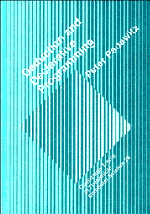Book contents
4 - Computing Goal Solutions
Published online by Cambridge University Press: 24 October 2009
Summary
The cut calculus for Horn clauses is simple, but rather inefficient as the basis of a theorem prover. To prove a goal γ via this calculus means to derive γ from axioms (those of the specification and congruence axioms for equality predicates) using CUT and SUB (cf. Sect. 1.2). In contrast, the inference rules resolution (cf. [Rob65]) and paramodulation (cf. [RW69]) allow us to start out from γ and apply axioms for transforming γ into the empty goal ∅. The actual purpose of resolution and paramodulation is to compute goal solutions (cf. Sect. 1.2): If γ can be transformed into ∅, then γ is solvable. The derivation process involves constructing a solution f, and ∅ indicates the validity of γ[f].
A single derivation step from γ to via resolution or paramodulation proves the clause γ[g]⇐δ for some g. Since γ[g] is the conclusion of a Horn clause, which, if viewed as a logic program, is expanded (into γ), we call such derivations expansions. More precisely, the rules are input resolution and paramodulation where one of the two clauses to be transformed stems from an “input” set of axioms or, in the case of inductive expansion (cf. Chapter 5), arbitrary lemmas or induction hypotheses.
While input resolution is always “solution complete”, input paramodulation has this property only if the input set includes all functionally-reflexive axioms, i.e., equations of the form Fx≡Fx (cf., e.g., [Hö189]).
- Type
- Chapter
- Information
- Deductive and Declarative Programming , pp. 47 - 52Publisher: Cambridge University PressPrint publication year: 1992



